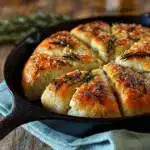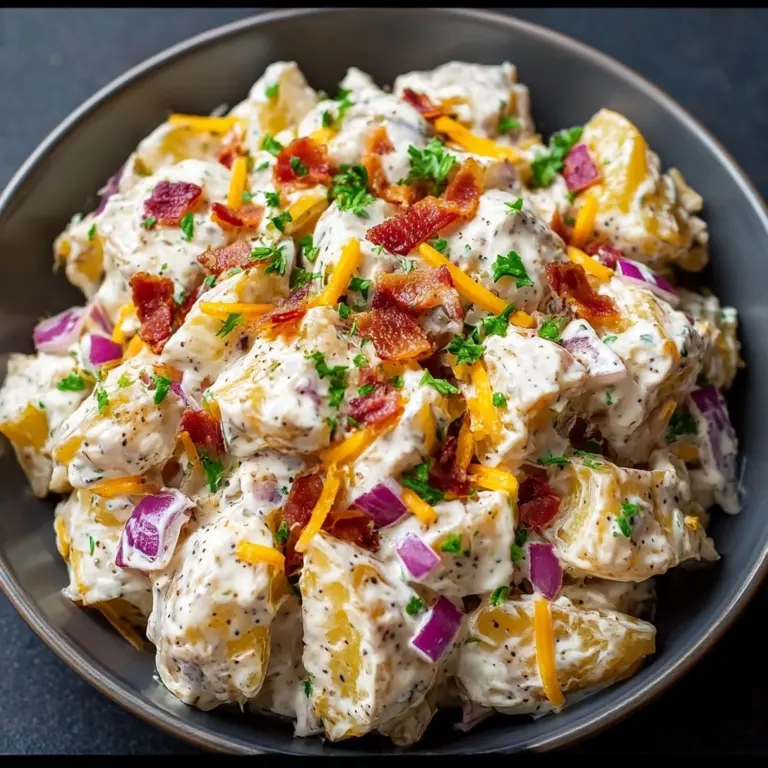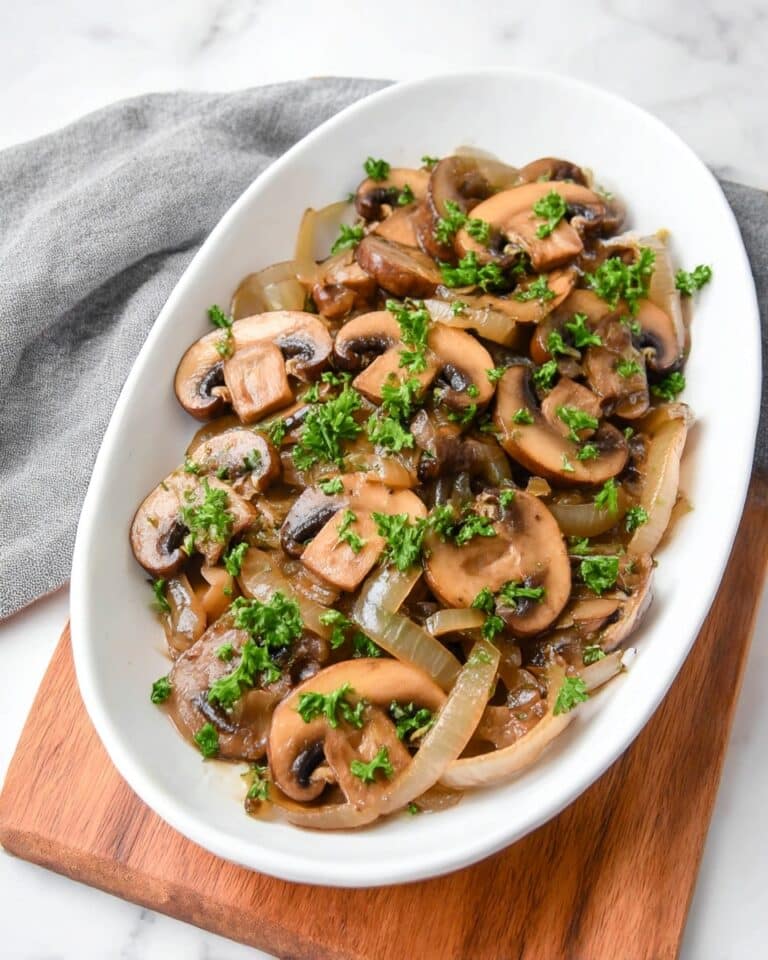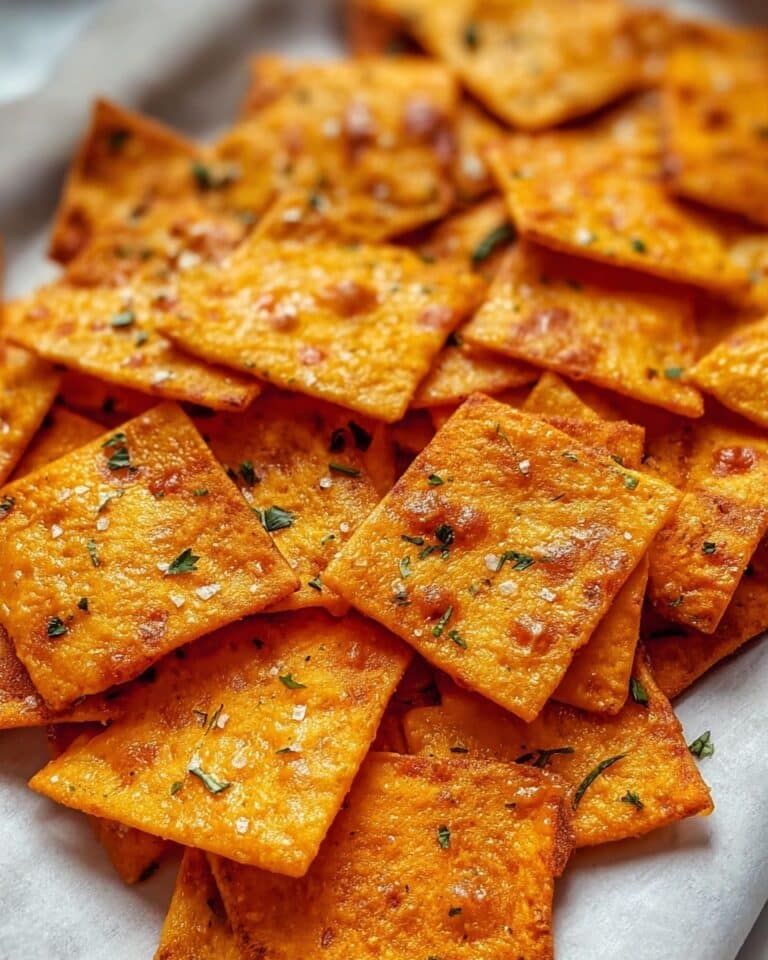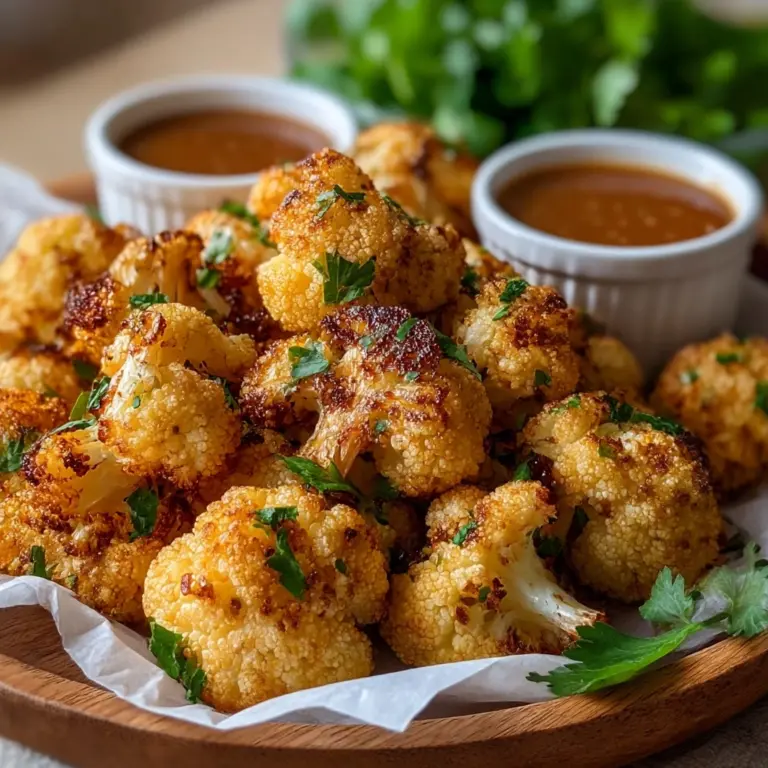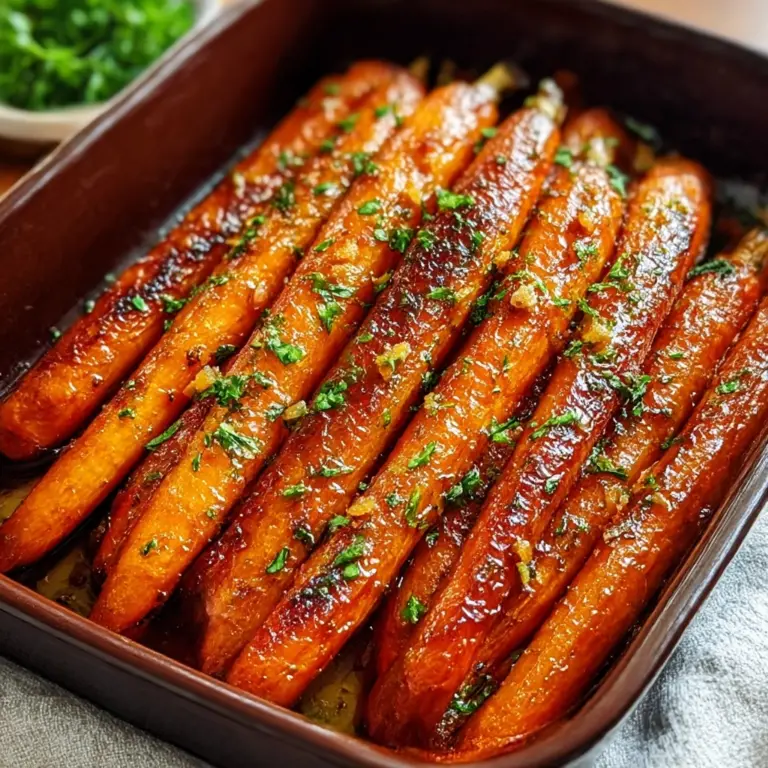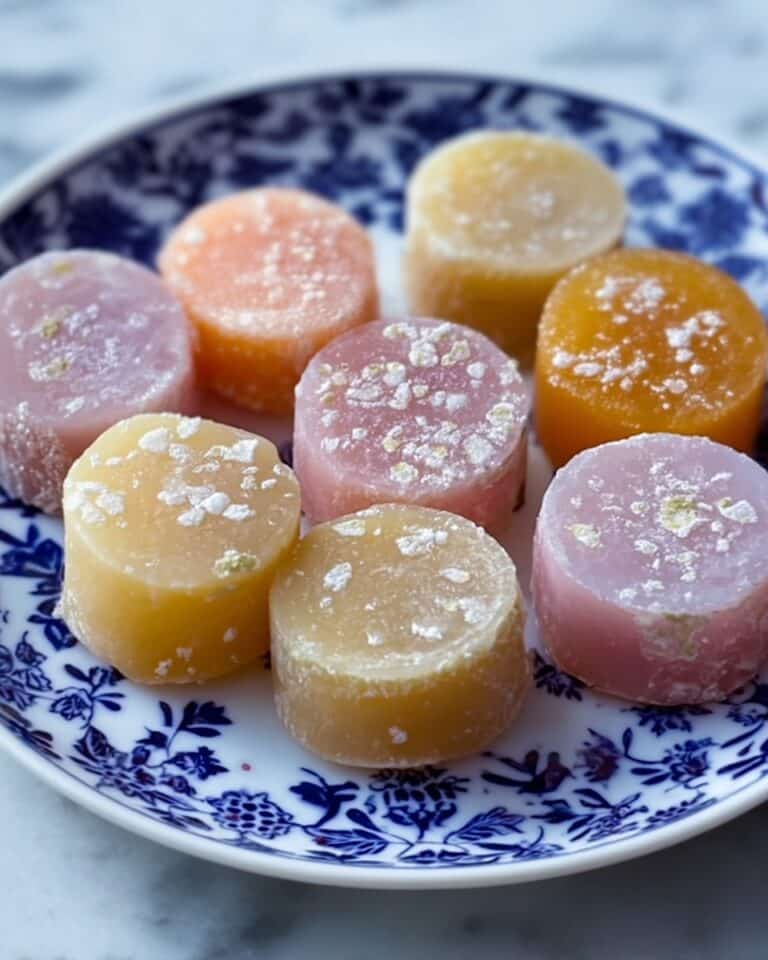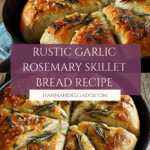Irresistibly Easy Rustic Garlic Rosemary Skillet Bread Recipe
If you’re craving something truly delicious yet wonderfully simple, the Irresistibly Easy Rustic Garlic Rosemary Skillet Bread is your new best friend in the kitchen. This bread is everything you want on your table: fragrant garlic and fresh rosemary combined with a perfectly chewy, golden crust baked right in a cast iron skillet. Each bite delivers warmth and rustic charm that pairs beautifully with almost any meal or stands on its own as a snack. Trust me, once you make this bread, it will quickly become a go-to recipe that delights family and friends alike.
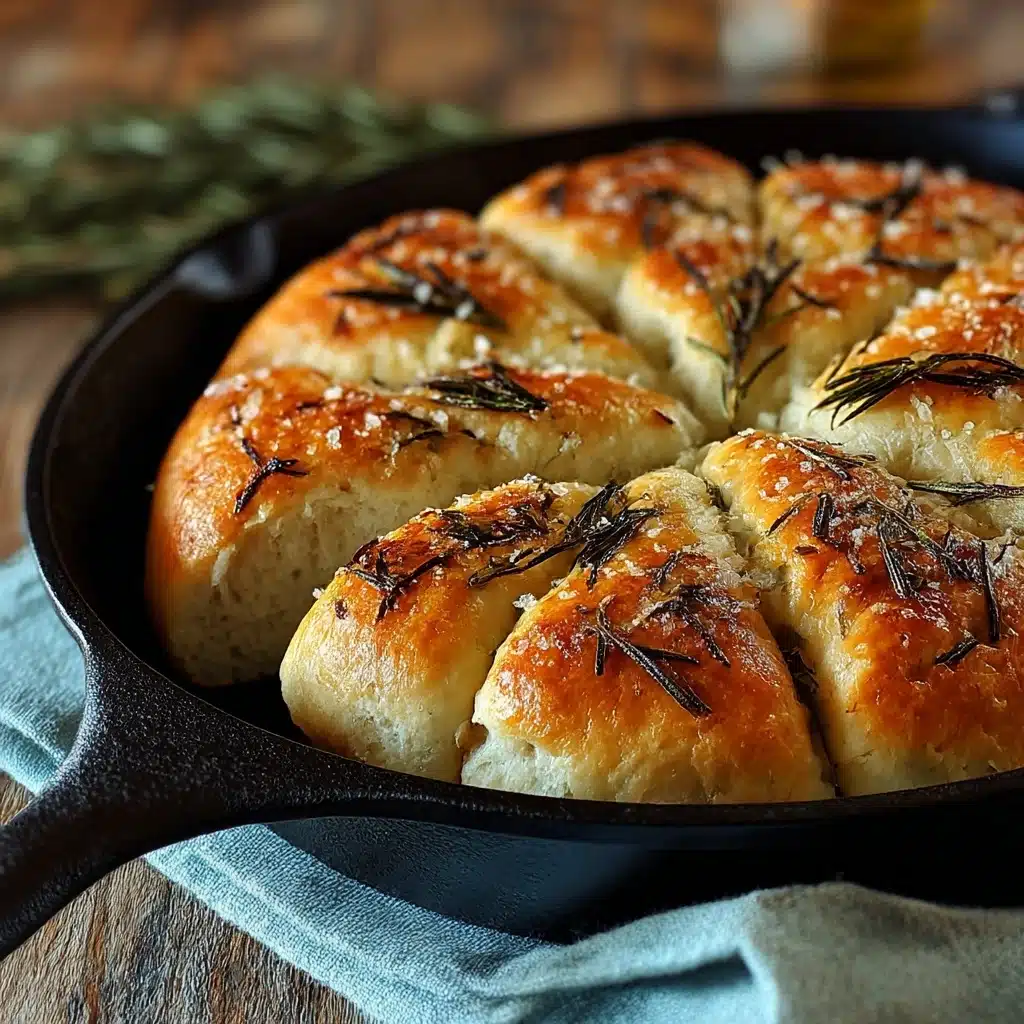
Ingredients You’ll Need
Gathering the right ingredients is the first step to creating magic. This recipe relies on a handful of everyday pantry staples that laugh at complexity but deliver fantastic flavor and texture. Each ingredient plays a crucial role, whether that’s activating the yeast, bringing moisture and richness, or layering in the unmistakable taste of garlic and rosemary.
- 3 cups all-purpose or bread flour: Bread flour brings out a chewier texture, ideal for that rustic feel.
- 1 tablespoon sugar: A sweet touch that feeds the yeast, you can swap honey if you like a more natural sweetness.
- 2 teaspoons rapid rise instant yeast: Make sure it’s fresh so your bread gets that perfect rise.
- 1 teaspoon sea salt: Enhances flavor; kosher salt works well too.
- ¼ cup olive oil: Adds richness and helps the crust crisp beautifully; melted butter or avocado oil can be swapped in.
- 1 cup warm water (125-130°F): The perfect temperature to wake up the yeast without killing it.
- 3 cloves garlic: Either sliced or minced, roasted garlic can soften the bite and add sweetness.
- 2 tablespoons fresh rosemary: Dried rosemary works if you reduce to 1 teaspoon, but fresh gives the best burst of aroma and flavor.
How to Make Irresistibly Easy Rustic Garlic Rosemary Skillet Bread
Step 1: Mix the Dry Ingredients
Start by combining the flour, sugar, yeast, and most of the salt in a large bowl. This simple combination is the foundation upon which all your flavors and textures will build, so mixing them evenly sets you up for success.
Step 2: Activate the Yeast with Wet Ingredients
Warm your olive oil and water together until they reach around 125-130°F. This temperature range is crucial because it activates the yeast without killing it. Mix these wet ingredients into your dry mix until you get a soft dough. This dough is the heart of your bread, so getting the right feel here starts the process off on the right foot.
Step 3: Knead to Perfection
Knead the dough either by hand for 8 to 10 minutes or with a stand mixer for about 2 minutes. You’re looking for a smooth, elastic texture, which means the gluten has developed enough to give you that satisfying chewiness in your finished bread.
Step 4: Let the Dough Rest
Cover your kneaded dough and let it rest for 10 minutes. This brief rest allows the gluten to relax, making it easier to shape later on without resistance. This step may seem small, but it makes a noticeable difference.
Step 5: Prepare the Skillet and Shape the Dough
Grease your 10-inch cast iron skillet with a tablespoon of olive oil. Place the dough ball in the skillet and create a criss-cross pattern with a sharp knife. This simple scoring allows the bread to expand beautifully as it bakes.
Step 6: Add Flavor and Let it Rise
Brush the dough with the remaining olive oil, then sprinkle on your garlic, fresh rosemary, and a little pinch of salt. Cover the dough again and allow it to rise for an hour. This slow rise develops flavor and creates a tender interior crumb.
Step 7: Bake to Golden Perfection
Preheat your oven to 400°F, then bake the bread for 20-25 minutes, watching for a gorgeous golden brown crust. The cast iron skillet works its magic by mimicking a traditional bread oven, creating a beautifully even bake.
Step 8: Cool Before Enjoying
Carefully remove the hot skillet from the oven and transfer the bread onto a wire rack to cool. This keeps the bottom from getting soggy and lets you savor that perfect crust and crumb with every bite.
How to Serve Irresistibly Easy Rustic Garlic Rosemary Skillet Bread
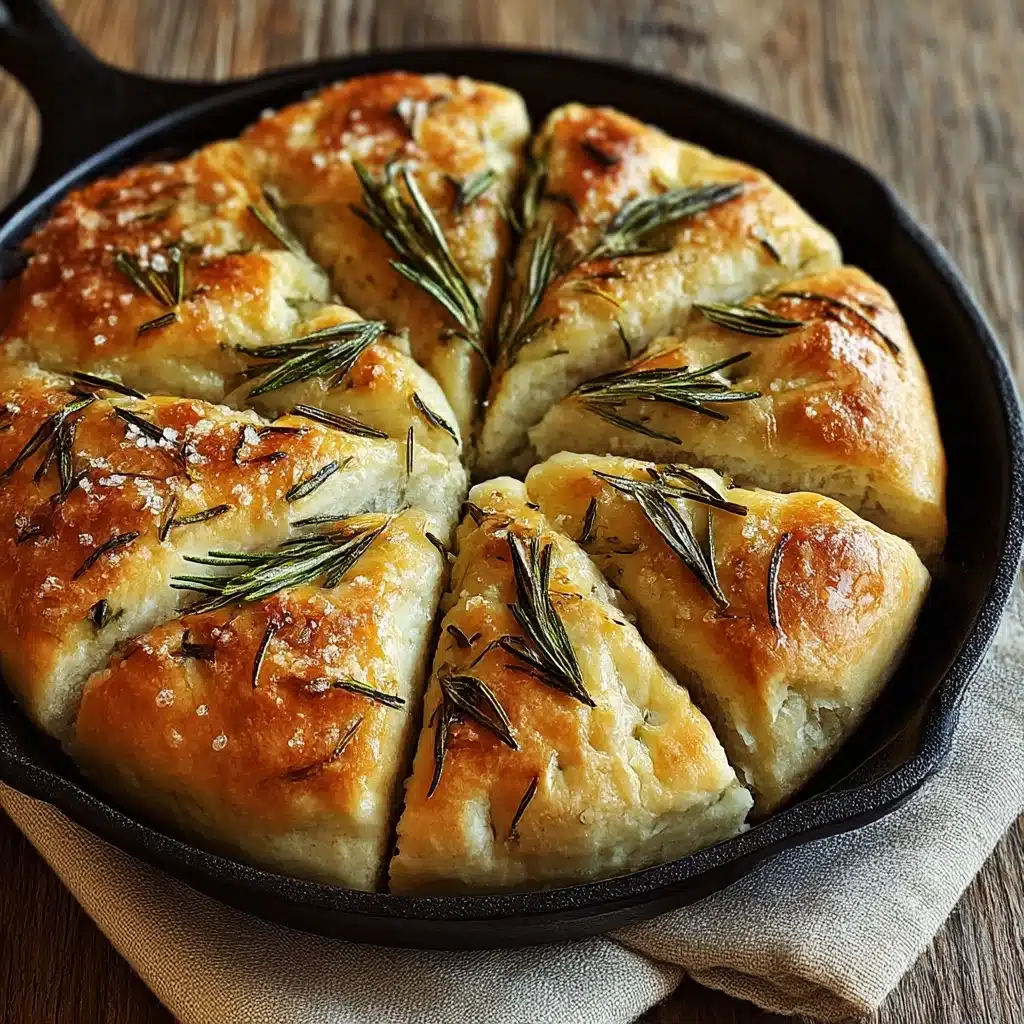
Garnishes
This bread shines on its own but, for an extra special touch, drizzle a little more olive oil or melted butter over the top just before serving. A sprinkle of flaky sea salt or a dusting of grated Parmesan also pairs beautifully with the garlic and rosemary, making the flavors pop.
Side Dishes
Pair this skillet bread with soups like creamy tomato bisque or hearty minestrone to soak up every last drop. It’s also incredible alongside roasted vegetables, grilled meats, or a fresh salad, making your meal feel cozy and complete.
Creative Ways to Present
For a fantastic appetizer, slice the bread and serve it with a variety of dips, such as hummus, olive tapenade, or a warm cheese fondue. Or slice it open and tuck in fresh mozzarella and tomato for a quick rustic sandwich that’s full of flavor and charm.
Make Ahead and Storage
Storing Leftovers
Wrap any leftover bread tightly in plastic wrap or place it in an airtight container. It will stay fresh for 2 to 3 days at room temperature, perfect for enjoying as toast the next morning or as an accompaniment to other meals.
Freezing
If you want to keep your Irresistibly Easy Rustic Garlic Rosemary Skillet Bread longer, freezing is an excellent option. Wrap it tightly in foil and place it in a freezer bag. It can last up to 3 months frozen without losing any of its delicious flavor and texture.
Reheating
To enjoy your bread warm again, thaw it at room temperature if frozen, then pop it in a 350°F oven for about 10 minutes. This revives the crust’s crispiness and warms the soft interior, just like fresh from the oven.
FAQs
Can I use all-purpose flour instead of bread flour?
Absolutely! Using all-purpose flour will still yield tasty bread, though the texture may be a little less chewy than when using bread flour. It’s a flexible recipe that works well either way.
What if I don’t have fresh rosemary?
You can use dried rosemary, but reduce the amount to about 1 teaspoon since dried herbs are more concentrated. Fresh rosemary gives the best aroma, but dried is a handy substitute.
Can I make this bread without a stand mixer?
Yes! Kneading by hand is perfectly fine. It just takes a little longer (about 8-10 minutes) and a bit more elbow grease, but it’s a wonderful way to connect with your dough.
Is it necessary to cover the dough while it rises?
Covering helps keep the dough moist and at a steady temperature, preventing a crust from forming on top. You can use a damp kitchen towel or plastic wrap for this step.
Can I add other herbs or flavors?
Definitely! Feel free to experiment by adding thyme, oregano, or even sun-dried tomatoes to make the bread your own. This recipe is a fantastic base for creative twists.
Final Thoughts
Making the Irresistibly Easy Rustic Garlic Rosemary Skillet Bread is truly a rewarding experience that fills your home with mouthwatering aromas and ends with a warm, hearty loaf that everyone will adore. It’s simple enough for beginners but impressive enough to share at special gatherings. So go ahead, gather your ingredients, and bake this charming bread—you’ll wonder how you ever lived without it.
PrintIrresistibly Easy Rustic Garlic Rosemary Skillet Bread Recipe
This Irresistibly Easy Rustic Garlic Rosemary Skillet Bread is a flavorful, chewy loaf baked directly in a cast iron skillet. Infused with fresh garlic and rosemary, this bread combines simple ingredients and straightforward methods to deliver a warm, aromatic, and rustic bread perfect for any occasion.
- Prep Time: 15 minutes
- Cook Time: 25 minutes
- Total Time: 1 hour 40 minutes
- Yield: 1 10-inch loaf 1x
- Category: Bread
- Method: Baking
- Cuisine: Rustic/Western
- Diet: Vegetarian
Ingredients
For the Dough
- 3 cups all-purpose or bread flour
- 1 tablespoon sugar (can be substituted with honey)
- 2 teaspoons rapid rise instant yeast
- 1 teaspoon sea salt (kosher salt alternative)
- ¼ cup olive oil (can be substituted with melted butter or avocado oil)
- 1 cup warm water (125-130°F)
For the Flavor
- 3 cloves garlic (sliced or minced; roasted garlic for milder taste)
- 2 tablespoons fresh rosemary (or 1 teaspoon dried rosemary)
Equipment
- 10” cast iron skillet
- Stand mixer
- Large bowl
- Wire rack
Instructions
- Mix Dry Ingredients: In a large bowl, combine the flour, sugar, yeast, and ¾ teaspoon of salt to create an even mixture.
- Combine Wet Ingredients: Heat ¼ cup of olive oil and 1 cup of water to approximately 125-130°F to activate the yeast properly. Mix this liquid with the dry ingredients until a soft dough begins to form.
- Knead the Dough: Use a stand mixer to knead the dough for about 2 minutes, or knead by hand for 8-10 minutes until the dough becomes smooth and elastic.
- Rest the Dough: Cover the kneaded dough and let it rest for 10 minutes to start gluten development and yeast activation.
- Prepare the Skillet: Grease the cast iron skillet with 1 tablespoon of olive oil, then place the dough ball in the center of the skillet.
- Add Flavor: Make a criss-cross cut on the top of the dough with a knife. Brush the surface with the remaining olive oil, then evenly sprinkle the garlic, rosemary, and an optional pinch of salt over the top.
- First Rise: Cover the skillet and let the dough rise for about one hour until it doubles in size.
- Bake the Bread: Preheat your oven to 400°F (204°C). Place the skillet in the oven and bake the bread for 20-25 minutes, or until the crust is golden brown and cooked through.
- Cool: Remove the skillet carefully from the oven, take the bread out, and allow it to cool on a wire rack before slicing and serving.
Notes
- Using bread flour gives a chewier texture compared to all-purpose flour.
- If using dried rosemary instead of fresh, reduce to 1 teaspoon to avoid overpowering the bread.
- Warm water between 125-130°F is critical for proper yeast activation.
- Kneading by hand takes longer but develops good gluten structure.
- Roasted garlic provides a milder flavor if preferred.
- Ensure your yeast is fresh for optimal rising.
- The cast iron skillet helps create a rustic crust and even baking.
Nutrition
- Serving Size: 1 slice (approximately 1/8 of the loaf)
- Calories: 180 kcal
- Sugar: 2 g
- Sodium: 220 mg
- Fat: 6 g
- Saturated Fat: 0.9 g
- Unsaturated Fat: 4.5 g
- Trans Fat: 0 g
- Carbohydrates: 27 g
- Fiber: 2 g
- Protein: 5 g
- Cholesterol: 0 mg
Keywords: rustic bread, garlic bread, rosemary bread, skillet bread, homemade bread, easy bread recipe, cast iron bread

